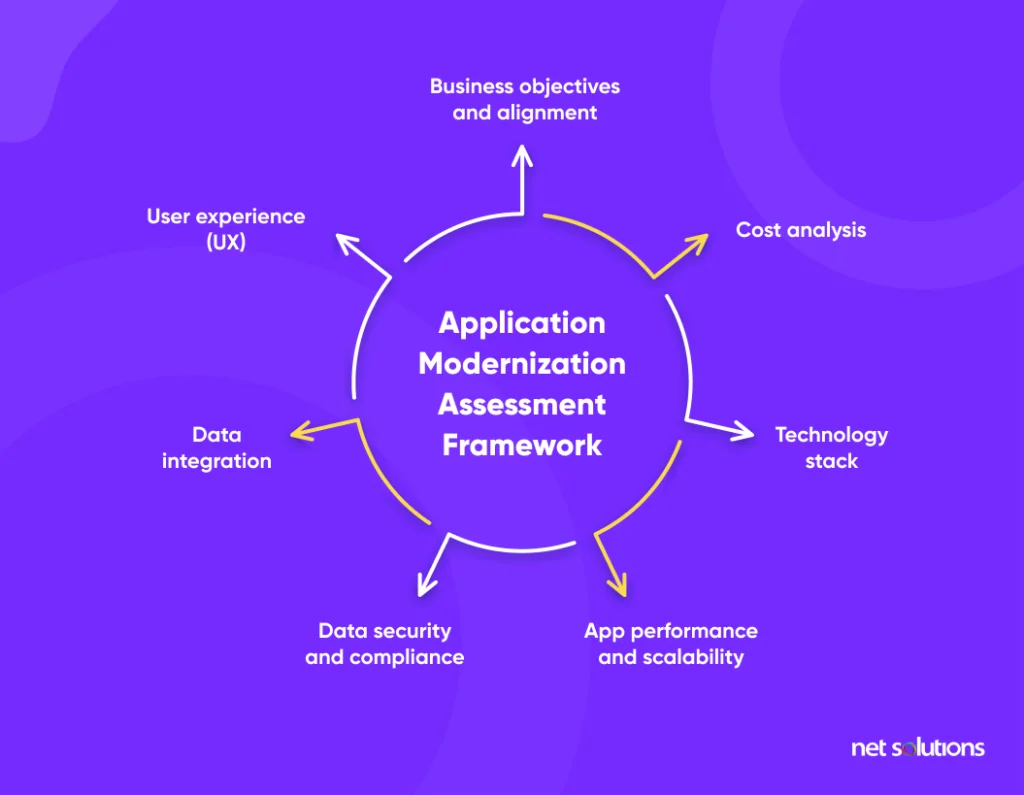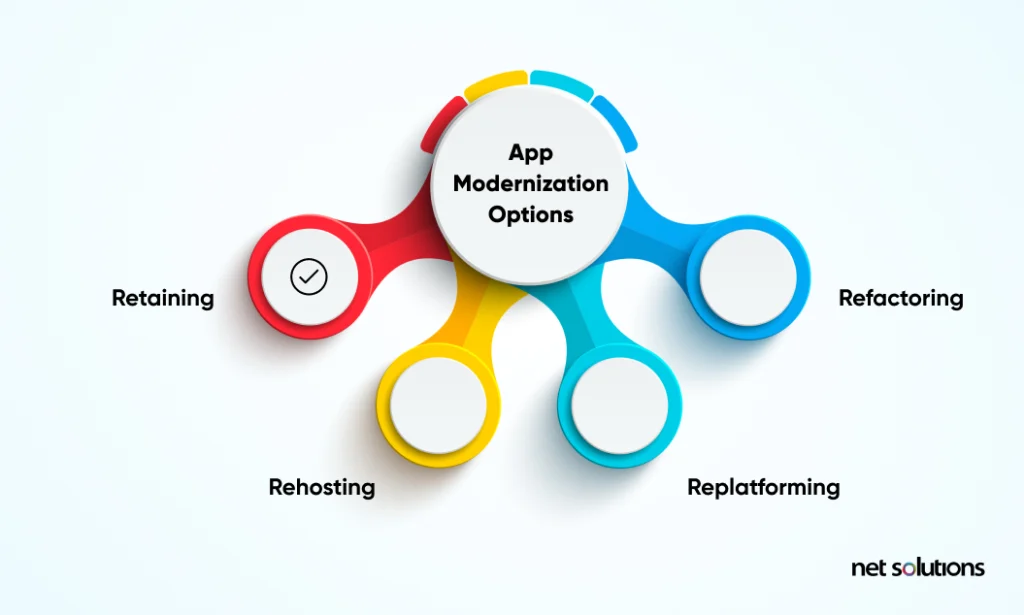Software engineers use the term “framework” to describe a template for approaching software development, but the concept of a framework isn’t limited to writing code and development software alone.
When planning an app modernization strategy, IT teams often find it helpful to think in terms of a modernization framework—a template for app modernization assessment that ensures a systematic, strategic approach, guiding the entire initiative.
This blog post explores seven key elements of a strategically planned and executed app modernization strategy, and these elements will guide your app modernization roadmap.
Application Modernization Assessment Framework
A framework-based approach to app modernization assessment will address all the key elements required to reduce risk and maximize the business value of our efforts.
Adopt the following seven concepts for your app modernization assessment framework to increase your odds of success.

1. Business objectives and alignment
Any app modernization strategy exists to serve an organization’s business goal, and as such, your assessment should be clearly focused on meaningful business outcomes. After all, upgrading for the sake of upgrading won’t support your business needs.
When creating your business case for app modernization, consider:
- How existing applications fall short in terms of functionality and customer experience
- Stakeholder needs and user experience
- Current workloads and how cloud adoption can optimize them
- Ways in which modernization and adopting cloud-native apps can:
- Reduce dependencies
- Improve data collection and processing
- Offer access to Artificial Intelligence (AI) technology
- Increase automation capabilities
- Improve overall performance
Target your initial modernization efforts on critical applications that align with your long-term success and maximize ROI.
2. Cost analysis
App modernization isn’t cheap, but when done right, it can offer a powerful return on your investment. Taking a strategic, framework-based approach means making a clear assessment of all the project costs associated with your initiative, including:
- Infrastructure costs for cloud services
- Labor costs for new app development, cloud migration, and managed services
- Costs to ensure cybersecurity and compliance standards are met
- Costs associated with Quality Assurance (QA) and testing
You may not have the budget for a complete overhaul of all your apps, so you’ll want to prioritize the most critical upgrades. Refactoring (completely rewriting the code for each app to make it cloud-native) is the most comprehensive solution, but you may opt for less extensive solutions (like replatforming) for certain apps.
3. Technology stack
Choosing the right technology stack is key to achieving a competitive edge, and that means tailoring your software, programming languages, frameworks, databases, and cloud infrastructure services (e.g., AWS, Microsoft Azure) to suit your specific needs.
We wrote a blog post about choosing the right tech stack for your industry, with specific recommendations for the following sectors:
- Retail and eCommerce
- Healthcare
- Finance
- Education
- Media, Publishing, and Entertainment
- Sports and Fitness
If you’re in any of these industries, or any other industry with similar technological needs, be sure to check out that post.
Choosing the right tech stack can help you:
- Reduce operational costs by creating efficient workflows with fewer workarounds
- Achieve greater overall efficiency that can increase your bottom line
- Reduce security risks by employing the latest cybersecurity principles
Consider important factors such as cost, scalability, and any topics related to your industry needs. For example, U.S. healthcare companies will need to access technology that helps them remain HIPAA compliant by prioritizing patient privacy.
Meanwhile, financial companies will need technology that supports multi-factor authentication, along with other security and compliance requirements.
4. App performance and scalability
One key factor to consider when prioritizing app modernization projects is how scalable key legacy applications are within your current ecosystem.
Scalability is one of the most important benefits of app modernization, thanks to the flexibility that comes with cloud-native apps based on headless, microservices architecture and containerization.
Modern apps allow companies to:
- Add new features without completely reinventing a given app
- Avoid many issues with dependencies that are common to legacy apps
- Decouple the front end from the backend of a given app to serve different applications and multiple purposes
A framework-based approach to app modernization means identifying critical applications to determine which ones would benefit from immediate upgrades. Those are the apps you’ll want to target first.
In other words, target those apps that will provide the greatest flexibility and have the strongest impact on improving your business operations.
5. Data security and compliance
Data security plays such a pivotal role in today’s climate of phishing scams, ransomware, and other cybersecurity threats that it must be considered a top priority in your assessment phase.
During your app assessment, identify any challenges your legacy applications may pose in the near-term and how app modernization can help solve them. Modern apps tend to be more secure than legacy apps, and keeping legacy apps secure once their creators stop supporting them can be even more time-consuming and costly.
Compliance is closely tied to security, and modern applications often make it easier to address compliance requirements in industries like finance, healthcare, and eCommerce, where regulations abound.
6. Data integration
Outmoded applications often struggle to collect and process data, creating data siloes and making it difficult to learn the valuable lessons your data has to teach you.
Modern apps are designed for data collection and processing, which means you can gain valuable insights about user behavior, current business processes, and customer drives. API integrations and advanced middleware make it all possible.
One example of a retailer successfully harnessing data from its modern systems is Under Armour. The sports apparel retailer purchased a number of fitness apps, including MyFitnessPal, and used that data to predict a walking trend in Australia—opening the doors to a powerful marketing opportunity before anyone else caught wind of it.
You can read about the Under Armour example and others in our post about digital transformation case studies among legacy corporations. Companies like Walmart, Home Depot, and Nike are harnessing the power of data to optimize supply chains, improve the customer experience, and more.
7. User experience (UX)
Another key framework that should guide your assessment roadmap relates to your overall User Experience (UX). Modern apps, with their flexibility, interoperability, and data-collection capabilities allow you to improve your UX in a variety of ways. A better UX typically means improved efficiency for internal operations and happier customers.
App modernization helps improve the User Experience through:
- Responsive design
- Intuitive navigation
- Better data that shapes continual improvement efforts
- Greater efficiency for internal operations
- Improved Customer Experience
When performing your app modernization assessment, focus on those apps that will empower you to improve your UX and enhance your business value.
App Modernization Options
Once you’ve completed our app modernization efforts, it’s time to identify the approach you’ll take for each software system.
Are you looking at completely rewriting the underlying code for a given app? Instead, do you want to use API technology that allows legacy apps to function on the cloud and interact with other apps? Something in between?

AWS identified the 7R model of app modernization, which we cover in our guide to app modernization. Among the 7Rs are four key ones: Retaining, rehosting, replatforming, refactoring, and rebuilding. Here is a brief introduction to each, but be sure to visit the link above for a more detailed analysis of all your options.
Retaining: Retaining a legacy application involves keeping the existing application and wrapping an API layer around it so it can interact with other cloud-based apps.
Rehosting: The “lift and shift” strategy of rehosting involves redeploying workloads to the cloud without changing the app’s core architecture or source code.
Replatforming: Also known as a “lift and reshape” approach, rehosting involves moving apps to the cloud and optimizing them in various ways without greatly altering the source code or the underlying architecture.
Refactoring: Refactoring involves completely rewriting the source code and rebuilding the architecture to create an app that is cloud-native, headless, and able to make full use of microservices and containerization technologies.
As you might imagine, the more extensive the solution, the greater the upfront cost. Choosing the appropriate strategy for your organization will require you to balance your immediate budget with your long-term business requirements.
How to Find the Right App Modernization Partner
It’s often helpful to hire an outsourcing partner to either lead or support your app modernization efforts because most in-house IT staff can’t drop everything to focus on app modernization. Plus, it’s likely many don’t have extensive experience with app modernization.
When hiring an app modernization partner, look for the following criteria:
- Extensive experience in enterprise app modernization
- Solid client reviews on websites like clutch.co
- Many years of experience in software development
- A strong industry reputation
- Numerous case studies that demonstrate an understanding of best practices for implementing app modernization strategies
- Fluency in your operating language and a willingness to adapt to your time zone, if that’s something you require
Choosing the right outsourcing partner can make or break your app modernization initiative, so don’t be afraid to ask challenging questions and put clear contracts in place to define the scope of work.
Ready to Modernize Your Legacy Apps?
Net Solutions is an award-winning IT outsourcing firm with more than two decades of experience, helping leading organizations like Euro Car Parts and American Golf to build powerful software and spearhead their legacy app modernization strategies. We’ve received excellent reviews from our clients, we’re fluent in English, and our team members can adapt to your local hours if that works to your advantage.
SHARE THIS POST
Table of Contents
Related Services
Related Resources
- App Modernization Benefits To Boost Your ROI and Future-Proof Your Business
- 11 Top Application Modernization Best Practices in 2025
- Building a Winning Application Modernization Business Case
- Legacy Application Modernization Case Studies & Success Stories
- Solving the Toughest Application Modernization Challenges
- Cloud-Native Application Modernization: Benefits & Strategies
- 8 Core Application Modernization Drivers
- Enterprise Application Modernization: Complete Guide [2025]
- Lift and Shift: The Modernization Formula for Legacy Apps
- Navigating Application Migration and Modernization [Guide]
- Application Modernization and Optimization: A Complete Guide
- A Practical Approach to Application Rationalization: A CIO's Guide to Managing Complexity and Reducing Costs
- What is Replatforming? A Beginner's Guide to Upgrading Your Technology Stack
- 7 Steps to Build an Effective Application Modernization Roadmap
- Application Modernization Services Market: Comprehensive Analysis
- A Step by Step Guide to Application Modernization Strategy
- Explore the Best Application Modernization Tools and Resources
- 13 App Modernization Trends That Can Support and Optimize Your App Modernization Strategy


